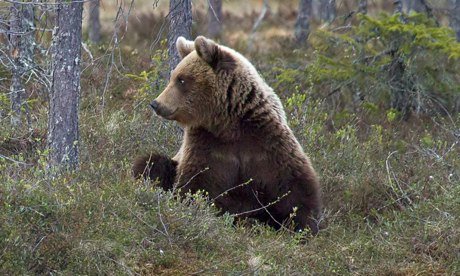The freezing polar vortex that has gripped the US has extended an abnormally mild winter in Scandinavia and disrupted the seasonal patterns of flora and fauna.
The weather system that brought snow, ice and record low temperatures to many parts of the United States this week left Iceland, Greenland and Scandinavia much warmer than normal.
On the back of a generally mild winter, there have been reports of bears emerging early from hibernation in Finland, changes in the behaviour of migratory birds off the coast of Sweden and plants appearing earlier than normal in Norway.
Scandinavia and Russia's cold weather during the winter comes from a high-pressure system that keeps warmer, more humid air and low-pressure systems with wind and rain from coming up from the Atlantic Ocean.
The weakening of the jetstream that holds this in place has allowed cold air to spill further south into much of the United States and Canada, while bringing above-average temperatures to parts of Europe.
The knock-on effects of the vortex follow one of the mildest Decembers in a century in Nordic countries. Ketil Isaksen, a scientist at the Norwegian Meteorological Institute, said the country had been 4.2C above the mean temperature for December with parts of Oslo and south-eastern Norway experiencing the third warmest December on record. "It was very unusual to see no snow in large areas where it is normal in December. Only in the mountains and certain parts of Norway could you find snow."
Much of the precipitation in lowland and populated areas had fallen as rain instead of snow, he said. "In general it was a very wet December. Large parts of Norway had up to three times as much rain as normal and the country as a whole had 180% more than average."
Finland too has seen heavy rain, with flooding in western coastal areas and the majority of Finland's lakes containing record volumes of water. Temperatures exceeded their normal seasonal average by 4-5C nationwide, with Helsinki and southern Finland recording the mildest second half of December in 30 years.
Temperatures in parts of Sweden have fluctuated greatly, at Nikkaluokta falling from 4.7C on 3 December to -40.8C on 9 December, then rising two days later to 7.7C. Many locations measured their warmest December temperatures on record. "In the north, winter has arrived, but in the south it's autumn according to the meteorological definition," the Swedish Meteorological and Hydrological Institute said.
The rainy weather in Finland has reportedly disrupted the winter slumbers of many bears, bringing them out of hibernation early. Heavy rains and high waters may have invaded some dens, forcing the animals to seek new shelter.
Prof Jon Swenson of the Norwegian University of Life Sciences, leader of the Scandinavian bear project, said he was worried about the indirect effects of the warmer weather. "If you go down into southern Europe, it's warmer, and there are some bears that don't hibernate.
"It doesn't seem to be harmful not to hibernate," he said. "What we are afraid of is that it means there will be more thawing periods … this really stresses the berry-producing plants. This can cause some mortality, and can have a very adverse effect on berry production. And that's what the bears survive on in the autumn, and what they use to get them through the winter. So the results of this mild weather won't be seen for some time."
Last week, the local Norwegian newspaper Sunnmørsposten published reader photographs of daffodils emerging as early as 14 December as well as crocuses, daisies, dandelions and honeysuckle.
The World Wide Fund for Nature (WWF) Norway chief executive, Nina Jensen, said she was "cautious about drawing conclusions from one mild winter into specific changes in nature", but there were signals that changes were happening.
"We are definitely seeing plants like bluebells flowering that wouldn't come out until spring, and birds singing that wouldn't normally be at this time of year. There are quite obvious changes in the growth season, plant growth and migratory bird routes and timing. The flip side of this warmer winter is that we will also have an increasing threat of harmful introduced organisms, such as the wild boar or ticks that thrive in warmer temperatures."
Pål Hermansen, a wildlife photographer based in Oslo, said: "It's the smaller things where you see it most, especially butterflies and other insects. The combination of 'proper winters' with lots of snow, alternating with winters like this one, makes everything very unstable. In the 30 years I've been working we've seen butterfly populations reduce by 80-90%. We're now seeing mosquitos and ticks during the winter, which is unheard of. Ticks are spreading much further north than they ever were before."
Stephen Menzie, an ornithologist working at Falsterbo Bird Observatory – a migration point in south-west Sweden – said it was "certainly true" that milder weather this year had played a part in delaying the southbound migration of many species.
"We had one day in November when we ringed over 800 birds, compared to the same period last year when we struggled to catch double figures on most days."

